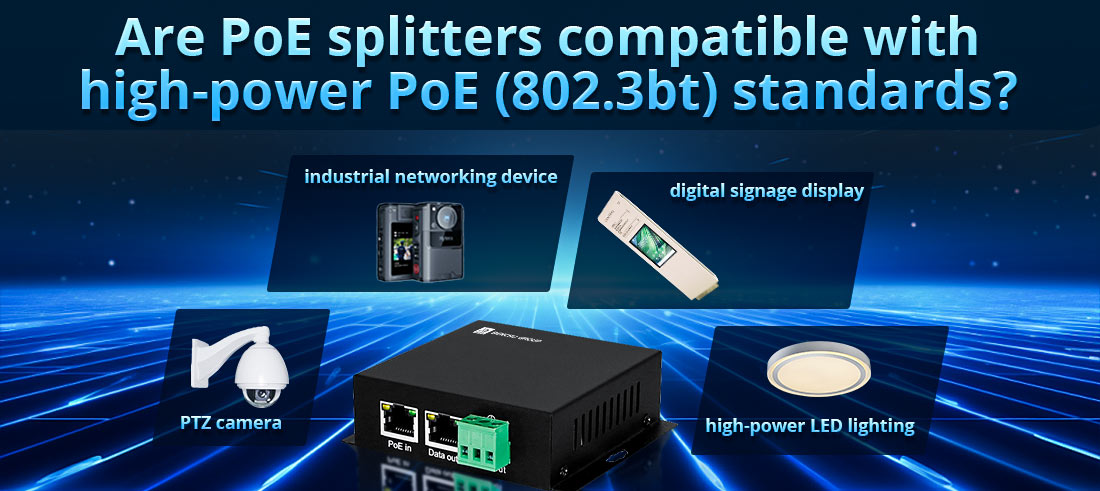
Les séparateurs PoE peuvent être compatibles avec les normes POE de haute puissance (802.3bt), mais la compatibilité dépend de la conception et de la capacité de traitement de l'énergie du séparateur. La norme IEEE 802.3BT, également connue sous le nom de PoE ++ ou 4PPOE, fournit jusqu'à 60W (type 3) ou 100W (type 4) par port, significativement plus élevé que les normes 802.3af (15,4W) et 802.3AT (30W).
Facteurs qui déterminent la compatibilité
1. Évaluation de puissance de Splitter Poe
--- pas tous Poe Splipters sont conçus pour gérer les niveaux de puissance supérieurs de 802.3bt. Lorsque vous utilisez une source POE de haute puissance (comme un commutateur ou un injecteur PoE ++), vous avez besoin d'un séparateur POE qui prend en charge 802.3bt. Si un séparateur n'est évalué que pour 802.3af (15.4W) ou 802.3at (30W), il n'utilisera pas entièrement la puissance disponible à partir d'une source 802.3bt.
2. Exigence de sortie de sortie pour le dispositif final
--- Un séparateur POE convertit l'entrée POE en puissance et sorties de données distinctes. Des dispositifs de haute puissance tels que l'équipement industriel, les grandes caméras PTZ, l'éclairage LED et les points d'accès sans fil (WAP) à haute performance nécessitent souvent plus de 30 W. Si votre périphérique final nécessite 60W ou 100W, un séparateur standard 802.3af / AT POE ne fonctionnera pas - vous avez besoin d'un séparateur qui prend explicitement le 802.3bt.
3. Capacité de conversion de tension
--- La plupart des séparateurs PoE fournissent une sortie de tension CC fixe (par exemple, 5V, 9V, 12V ou 24 V) en fonction des besoins du dispositif non-POE. 802.3bt Les séparateurs POE sont conçus pour gérer une puissance plus élevée tout en fournissant des tensions de sortie stables adaptées aux appareils de haute puissance. Certains séparateurs haut de gamme peuvent ajuster dynamiquement la tension de sortie en fonction du périphérique connecté.
4. Compatibilité arrière
--- Alors que les commutateurs et les injecteurs POE 802.3BT sont compatibles en arrière avec les normes POE plus anciennes, les séparateurs POE ne sont pas toujours compatibles vers l'avant. Un séparateur conçu pour 802.3af / AT peut ne pas reconnaître ou négocier correctement l'énergie à partir d'une source 802.3bt. Cependant, si un interrupteur 802.3bt est conçu pour détecter et fournir une puissance inférieure aux appareils non BT, il peut toujours fonctionner, mais uniquement à une puissance réduite.
Quand utiliser un séparateur POE compatible 802.3BT?
Vous devez utiliser un séparateur POE compatible 802.3BT lorsque:
--- La source POE est un commutateur ou un injecteur 802.3bt PoE ++ fournissant jusqu'à 60W ou 100W.
--- Le dispositif final nécessite plus de 30 W de puissance, ce qui dépasse la limite de 802.3af (15,4W) ou 802.3at (30W).
--- Le dispositif non-POE a une exigence de puissance plus élevée, comme une caméra PTZ avancée, un affichage de signalisation numérique, un éclairage LED haute puissance ou un dispositif de mise en réseau industriel.
Exemple de configuration pour l'utilisation d'un séparateur POE 802.3BT
1. Poe Source: A Poe ++ (802.3bt) commutateur ou injecteur fournit jusqu'à 60W / 100W sur un câble Ethernet.
2. Splitter PoE (802.3bt-compatible): Ce dispositif extrait la puissance du signal POE et le convertit en une sortie de tension CC appropriée (par exemple, 12V, 24 V ou sortie réglable).
3. Dispositif non-POE: L'alimentation extraite est livrée à un appareil non-POE, comme une machine industrielle, un panneau LED ou une caméra réseau plus ancien.
Limitations de l'utilisation des séparateurs POE avec 802.3bt
--- Tous les séparateurs POE ne prennent pas en charge 802.3bt: de nombreux séparateurs POE standard ne gèrent que 802.3af (15.4W) ou 802.3at (30W).
--- Perte de puissance potentielle: l'efficacité du séparateur et du processus de conversion affecte la quantité de puissance atteint le dispositif final.
--- Exigences d'alimentation spécifiques au périphérique: certains appareils ont besoin de niveaux de tension et d'ampérage précis, ce qui peut nécessiter un séparateur POE ajusté en fonction de la tension.
Conclusion
Les séparateurs POE peuvent être compatibles avec le POE de haute puissance 802.3BT, mais seulement s'ils sont spécifiquement conçus pour cela. Si vous utilisez un commutateur ou un injecteur PoE ++ (802.3bt) de haute puissance, vous devez choisir un séparateur POE qui prend en charge la sortie de 60 W ou 100W pour profiter pleinement de la capacité d'alimentation accrue. Vérifiez toujours les spécifications du séparateur POE et du périphérique connecté pour assurer un bon fonctionnement.